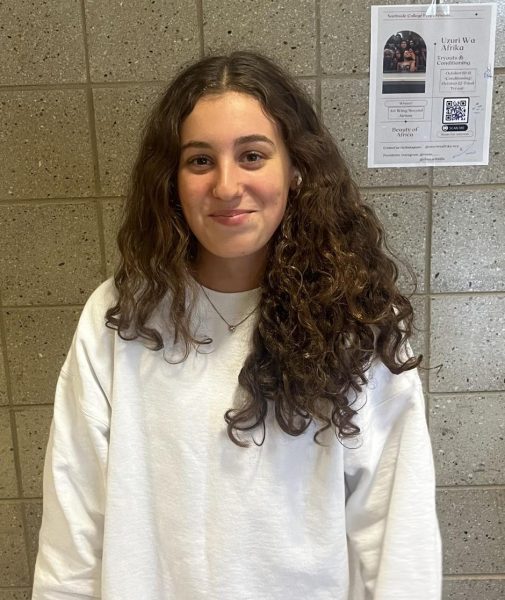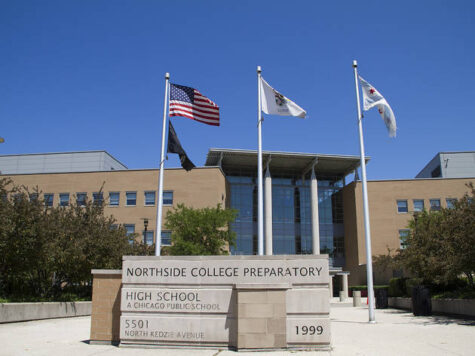Since the first week of classes, the school building has gone from 55-degree chills to 100-degree heat in various wings and classrooms. The temperature at Northside College Prep (NCP) has varied dramatically this school year, and it’s not what many students would have expected. Students have had to adapt to the temperature as the year has progressed.
What first comes to mind for many when thinking of the building’s extremely hot days are the infamous “Sweaty Floor Days.” During these days, the heat index in Chicago reached 116 degrees Fahrenheit (46.67 °C). This extreme temperature and elevated humidity caused the floors to become very slippery from the humidity, posing a safety hazard, hence the name “Sweaty Floor.”
This “Sweaty Floor Day” created a dangerous situation with slipping and sliding. Precautions were taken immediately. Long maroon rugs were placed throughout the halls to prevent accidents, and students were dismissed from school 15 minutes early. Extreme and unexpected temperatures have continued throughout the following months in the building.
Student Perspectives
The student body at NCP has been heavily impacted by the temperature in the building. Students have to pack clothes and dress for both cold and warm temperatures—coats on days when it is warm outside and shorts when it is cold out. Students have experienced these changing temperatures since the first day of school and can’t quite predict what each room or wing will feel like.
Alissia Anghel (Adv. 401) has had to adapt to the fluctuating temperatures over the years. “I remember during my junior year, [English] class was especially cold, so I would have to dress warmly. I would have AP US Government next where it was very warm, and I would have to dress in layers and constantly carry clothes with me… It was uncomfortable.”



Anghel advised NCP students to be prepared for the temperature changes. “I would say always keep something in your locker and always be prepared to dress warmer than you think you should because the building is often cold.”
Sinan Huda (Adv. 506) echoed this sentiment. “Wear a lot of layers. I have two hoodies with me and another three in my car at all times.”
Enkhjin Namuunbayar (Adv. 709) said that she sometimes brings a blanket to fight the cold temperatures. Ana Guset (Adv. 604) said she wears extra layers to stay warm.



Noah Jacinto (Adv. 409) says that this issue has affected him his entire time at NCP. “Ever since my freshman year, I have noticed changes in temperature, whether that be in extreme cold or extreme heat, depending on the season… It is really hard to focus when I am really cold or really hot.”
Samia Sheth (Adv. 409) said that she “can’t really focus or get her work done” when the temperature in the building is at an extreme.
The Data
Temperatures in the school have already hit extremes of warmth and cold this school year. Room 206 reached 100 degrees on October 10, while on August 31, room 321 was 55 degrees.
The city of Chicago has a heat ordinance that runs from September 15 to June 1. Between these dates, the ordinance states, “For workspaces, the indoor temperature is required to be 68°F when the space is occupied.” For more on the heat ordinance, please see the city’s page on it here.
Mrs. Sullivan (Math Department) has collected data on the temperature in room 323. The hottest day in room 323 was 78, and only a couple of days later on the 31, it was 60 degrees. The coldest week recorded was September 18-22, where the temperature averaged 65.5 degrees.

Why is this happening?
The Mechanics
Assistant Principal Barry Smith says the temperature in classrooms has been an issue since 2011 when he arrived at Northside. However, he feels that the ability to control the temperature in the building has become a growing problem over the past few years as the HVAC system has aged.
Mr. Smith says, “There are two giant boilers on the roof that run on either side of the building, and each one of these is a multi-hundred thousand dollar machine. There was almost an entire year when one of the two boilers did not work. When something like that breaks, it’s not Northside’s responsibility to fix it as we don’t fund capital projects.”
Chicago Public Schools is responsible for addressing physical plant issues. Mr. Smith added that some of the temperature issues today are reminiscent of the system’s last repair, particularly on the “Sweaty Floor Days.”

There are also challenges with operating the HVAC system that controls Northside. Mr. Smith said, “[When you are in your] house, and you want to turn up the temperature, you presumably go to your smart thermostat, and you just twist a little dial, and if you want it to go down, you turn it down.”
The technology running the HVAC is complex and outdated. “In here, there is a computer that is running like, Windows 95, if we’re lucky,” stated Mr. Smith.
Motors control the flow into rooms in the building. If a motor controlling the airflow in a room breaks, fixing it is a very complex process, Mr. Smith noted.
Another contributing factor to the temperature in the building is that the HVAC system is shut down as a cost-saving measure when the school is not in use. If the heat has been shut off in your house, it likely does not take very long to heat it up again. But, in a building the size of Northside, it takes a long time for the temperature to level out again.
Outside causes
Ms. Ayesha Qazi-Lampert (Science) says that climate change has worsened the temperature in the building, saying, “The intensity and frequency [of the temperature] has changed a ton in the past seven years, and it makes sense because of the impact of climate change and that we’re seeing a lot of weather extremes.”
She added, “When you see these fluctuations, our building cannot respond properly, and it’s impacting my instruction and learning.”
Ms. Qazi-Lampert also said that students in her class have a hard time focusing on learning when the temperature is extreme, leading to changes needing to be made in lesson plans.
What can be done?
The HVAC system likely requires a multi-million dollar project to repair it fully, according to Mr. Smith. Given how many schools do not have central air in CPS, this work could be challenging to get funding for. Other schools have extremely pressing improvements to their older buildings that need to be completed, such as removing asbestos.
Ms. Qazi-Lampert advocated for increasing funding for building improvements across CPS. “I think we need to advocate and fight for modernizing our current building because our buildings are not capable and are not able to handle [climate change]. Most CPS buildings are around 85 years old, but this building is about 23 years old.” Despite its relatively young age, Northside still struggles with temperature like other schools.
To address this, Ms. Qazi Lampert says “We need to advocate for policy change and funding. This needs to happen immediately because it impacts your learning and our teaching.”
Mr. Smith also acknowledged the frustrations and challenges that the temperature brings for students. “There are plenty of studies that show that fluctuations in temperature are not good for learning environments and focusing and concentration—I feel it every day as well.”










